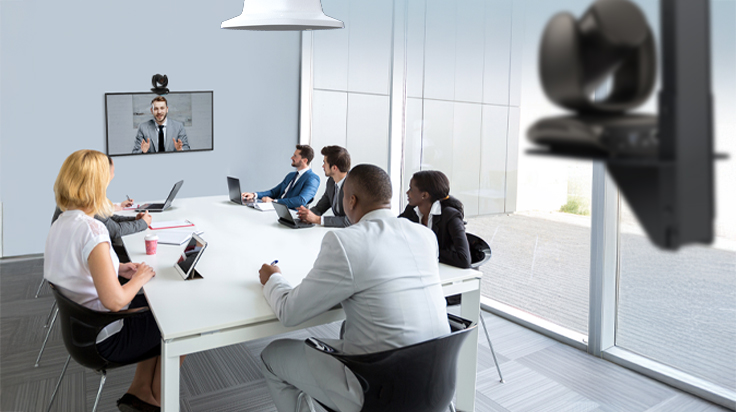The past couple of years has seen video conferencing being dominated by the rise of AI — and there’s no sign of this stopping. While AI will continue to have a huge impact on the video conferencing landscape, it’s also worth noting that security and user-focused features are set to take center stage in 2025. Add to this the return to the office movement of the past few years, and it’s no wonder that video conferencing is set to rise across all sectors.
AI tools are fast becoming the norm in video conferencing meetings. Platforms like Zoom Rooms are integrating AI meeting assistants that help schedule and manage the meeting process, doing everything from pairing devices to setting agendas to generating follow-up tasks. Automated meeting summaries are a welcome tool in reducing the need for manual note-taking while AI-powered live transcription and real-time translation are a wonderful new tool — particularly for global teams.
AI is also enhancing the quality and personalization of virtual interactions, leading to more engaging and focused meetings. Technologies like facial and voice detection enable features such as auto framing and speaker focus, readily available with devices like the VB370A when used with Zoom Rooms. Some systems can even analyze participants' tone and engagement levels to provide feedback on meeting effectiveness. AI has the ability now to streamline post-meeting workflows by tagging key discussion points, assigning action items, and syncing with project management tools like Asana or Trello.
2. Increased Demand for Video Bars
As companies prioritize clear, reliable communication in both on-site and hybrid meeting scenariosenvironments, video bars are also becoming a go-to device for meeting rooms for 2025. These all-in-one devices integrate a camera, microphone, and speaker into a single compact unit, simplifying setup and reducing cable clutter. Many models are PC-based while supporting conferencing apps. The VB370A, for example, is certified by Zoom and is powered by Android OS, offering a true plug-and-play experience.
The growing popularity of video bars is also tied to their scalability and compatibility. Businesses can add expandable microphones, integrate with touch panel systems, and even opt for remote management capabilities. This allows IT teams to monitor and update devices across multiple office locations from a single dashboard.
This combination of simplicity and centralized control makes video bars a go-to choice for companies looking to future-proof their hybrid collaboration strategy. As organizations expand across multiple locations, these easy-to-deploy solutions that ensure consistent video and audio quality is what is driving a 15.5% increase in a billion dollar market.
3. The Rise of Multi-Camera Solutions

Multi-cameras are allowing power users to take their meeting game to the next level. Organizations can now deliver immersive, professional-grade online experiences due to high-quality, PoE (Power over Ethernet) cameras, expandable audio systems. These setups are especially valuable during panel debates and live presentations for webinars and houses of worship, where switching between camera views enhances audience engagement and clarity.
Multi-camera solutions are key to delivering a more life-like and dynamic visual experience, ultimately making remote participation feel more natural and interactive. AVer offers innovative dual-camera solutions designed for this purpose. One option One of these solutions includes the VB370A video bar and a second camera from the AVer CAM Series, when used in conjunction with Zoom Rooms, allows for the possibility of two different camera angles for better engagement. Furthermore, for advanced needs, AVer provides the flexibility of combining two CAM550 cameras with up to four FONE700 ceiling speakerphones, ensuring optimal visual coverage and crystal-clear audio for any meeting space.
What’s driving the broader adoption of multi-camera setups is their growing affordability and increased integration with mainstream platforms, thus driving a projected market growth of 5.7 billion. With the support of advanced PTZ (pan-tilt-zoom functionality and AI camera tracking), you can have camera streams that follow a single presenter or facilitator while another stream can cover the audience or participants — all with minimal technical knowledge. In educational settings, this allows instructors to move freely without worrying about staying “in frame,” while in corporate settings, it adds a layer of professionalism to town halls, training sessions, and client presentations.
4. BYOD & BYOM: Creating Flexible Workspaces
The growing adoption of BYOD (Bring Your Own Device) and BYOM (Bring Your Own Meeting) is transforming the way teammates interact in shared spaces. These models allow users to connect their own laptops, tablets, or smartphones to a room's AV system and run meetings on the platform of their choice — whether it’s Zoom, Microsoft Teams, or Google Meet.
This flexibility caters to the diverse tech preferences found in today’s hybrid workplaces and reduces the reliance on room-dedicated systems. Tools like Barco ClickShare make it easy to wirelessly connect personal devices to high-quality room cameras and audio systems. Moreover, modern meeting spaces are increasingly being designed with BYOD and BYOM in mind, incorporating features like universal USB-C connectivity and wireless display casting. These spaces offer a more user-first experience — allowing external guests, freelancers, and remote employees to collaborate with minimal setup time.
It’s important to recognize that while this improves the user experience, it also introduces a host of security and compatibility challenges for IT staff. IT teams now need to invest in solutions that maintain enterprise-grade security without compromising convenience, prompting organizations to implement tools like device tagging, detailed reporting and admin agents. Companies that embrace BYOD/BYOM strategies can reap the rewards of reduced hardware costs and support a wider range of work styles and preferences. AVer has a full line of cameras and different software, like Cloud Management, Enterprise Management, and Room Management to manage cameras installed in different environments.
Conclusion
As the technology continues to evolve for virtual meetings in 2025, so will the overall video conferencing industry. More intelligent tools, a user-driven focus, and exciting devices like video bars and multi-cameras will continue to innovate the video conferencing sphere. Hopefully everybody will be able to keep up.
Find the right kind of video conferencing solution from AVer to meet your own needs.